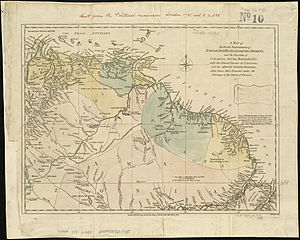- Dutch Guiana
-
Dutch Guiana, also known as Netherlands Guyana or Dutch Guyana (Dutch: Nederlands Guiana), is the name given to various Dutch colonies on the northern coast of South America, created by the Dutch West India Company. These colonies consisted of the land in between the Essequibo River and the Amazon River, an area known at the time in Dutch as De wilde kust ("the wild coast"). Today, the region is occupied by the present-day nations of Guyana and Suriname.
History
The first written reference to the region was in a 1599 map, drawn by Flemish cartographer Jodocus Hondius. Beginning in 1600, the colonies were settled by Dutch colonists, most of whom came from the province of Zeeland. Trading posts were established near various rivers, including the Pomeroon, Essequibo, Berbice, and Suriname rivers. Many small commercial establishments, mostly bartering posts, were founded by French, Dutch, and English colonists. Due to the effects of disease and attacks from natives, these colonies rarely lasted long.
The Dutch West India Company was created in 1621, and given unsupervised control of the colonies in South America. The colony was administered by Abraham van Peere, a Dutch explorer who had founded the settlement of Berbice. After the Third Anglo-Dutch War, England ceded the territory of modern-day Suriname, in exchange for New Amsterdam.
Dutch Guiana was not a political entity, but rather a geographical indication. The colonies that formed along Dutch Guiana were, initially, controlled by several entities. Essequibo and Demerara were controlled by the Dutch West India Company, while Berbice and Suriname were controlled by the Society of Berbice and the Society of Suriname, respectively. Cayenne (French Guiana) was also briefly controlled by the Dutch between 1660 and 1664, and again between 1676 and 1677.
Under the Batavian Republic, much of Dutch Guiana was once again occupied by the British. After the Napoleonic Wars in 1814, Britain gained control of the three colonies (Demerara, Berbice, and Essequibo) west of the Courantyne River. These three colonies became British Guiana. After 1815, there were five Guianas, referred to by their dominant languages: Spanish Guayana (Venezuela), British Guiana, Dutch Guiana, French Guiana, and Portuguese Guiana (Brazil).
The colony that remained continued to be a part of the Kingdom of the Netherlands until 1975, when the region became independent as the Republic of Suriname.
Dutch Empire Colonies and trading posts of the Dutch East India Company (1602-1798) GovernoratesAmbon · Banda · Batavia · Cape Colony · Ceylon · Coromandel · Formosa · Northeast coast of Java · Makassar · Malacca · MoluccasDirectoratesCommandmentsResidenciesSettlements with an opperhoofdColonies and trading posts of the Dutch West India Company (1621-1792) Colonies in the AmericasAcadia · Berbice† · Cayenne · Curaçao and Dependencies · Demerara · Essequibo · Brazil · New Netherland · Pomeroon · Sint Eustatius and Dependencies · Suriname‡ · Tobago · Virgin IslandsTrading posts in Africa† Governed by the Society of Berbice · ‡ Governed by the Society of Suriname Settlements of the Noordsche Compagnie (1614-1642) SettlementsColonies of the Kingdom of the Netherlands (1815-1962) Until 1825Until 1853Until 1872Until 1945Until 1954Until 1962† Became constituent countries of the Kingdom of the Netherlands; Suriname gained full independence in 1975, Curaçao and Dependencies was renamed to the Netherlands Antilles, which was eventually dissolved in 2010. Kingdom of the Netherlands (1954-Present) Constituent countriesPublic bodies of the NetherlandsCategories:- Netherlands Guiana
- Dutch colonization of the Americas
- 1975 disestablishments
- Former countries in South America
- History of South America
Wikimedia Foundation. 2010.

